You are here: Start » Filter Reference » Barcodes » ReadSingleBarcode
Detects and recognizes a single barcode on the input image.
| Name | Type | Range | Description | |
|---|---|---|---|---|
 |
inImage | Image | Input image | |
 |
inRoi | Rectangle2D* | Region of interest | |
 |
inRoiAlignment | CoordinateSystem2D* | Adjusts the region of interest to the position of the inspected object | |
 |
inBarcodeFormat | BarcodeFormat* | Format of the barcode | |
 |
inMinGradientLength | Real | 0.0 -  |
Minimal gradient length of edge pixels used for detecting barcodes |
 |
inBaseBarWidth | Integer | 1 -  |
Estimated width of the thinnest bar |
 |
inDetectionScanCount | Integer | 1 -  |
Number of scan lines used in detecting barcode |
 |
inReadingScanCount | Integer | 1 -  |
Number of parallel scans run until first successful read |
 |
inScanWidth | Integer | 1 -  |
Width of the single scan |
 |
inMinStrength | Real | 0.0 -  |
Minimal strength of an extracted edge |
 |
inSmoothingStdDev | Real | 0.0 -  |
Standard deviation of the gaussian smoothing applied to the profile extracted in each scan |
 |
outBarcodePosition | Rectangle2D? | Position of the found barcode | |
 |
outDecodedText | String? | Decoded barcode content or nothing if all of the scans failed | |
 |
outBarcodeFormat | BarcodeFormat? | Decoded barcode format or nothing if all of the scans failed | |
 |
outAlignedRoi | Rectangle2D | Input ROI after transformation (in the image coordinates) | |
 |
diagGradientImage | Image | Image of gradient directions | |
 |
diagBarcodeCandidates | Rectangle2DArray | Places with high gradient values that are further investigated | |
 |
diagScheduledScanSegments | Segment2DArray | Scheduled scan segments | |
Applications
Description
Hints
- Connect inImage with the output of your image acquisition filter.
- Select inBarcodeFormat according to the type of codes you want to read. If you choose the wrong format, the codes will not be recognized. Setting its value to Auto can increase the computation time considerably. Furthermore, the Auto value causes detection of UPC-A codes as EAN-13 codes.
- If the image quality is low, increase inMinGradientLength or increase inSmoothingStdDev. The diagGradientImage output shows how this affects an intermediate image.
- If the image resolution is high, increase inBaseBarWidth or resize/downsample the input image.
Examples
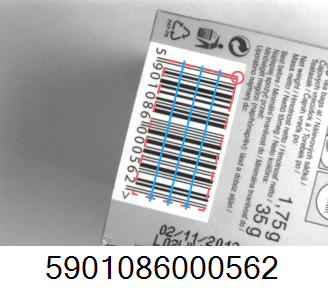
Rotated barcode. |
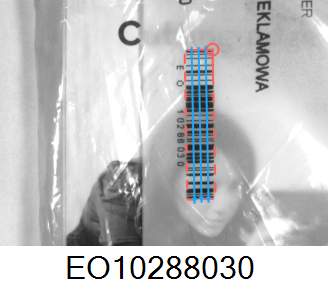
Low quality barcode printed on plastic foil. |

Barcode on package wrapped in plastic foil. |
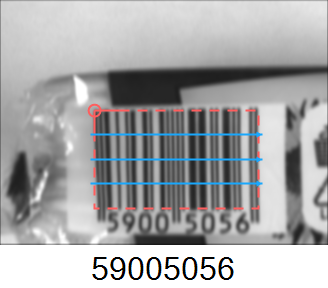
Barcode on blurry image. |
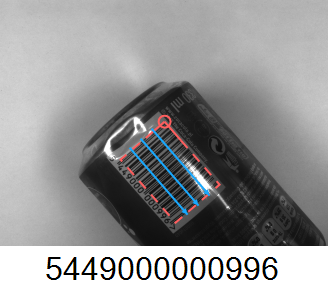
Barcode on standard 330ml can. |

Barcode on reflective and wrapped surface. |
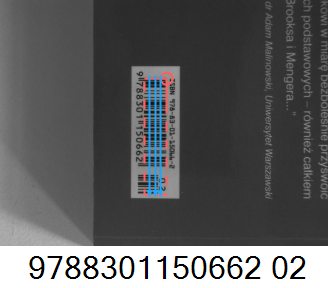
EAN-13 with add-on 2 used to indicate a book edition. |
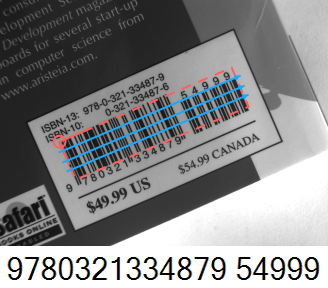
EAN-13 with add-on 5 to give a suggestion for the price. |
Remarks
Minimal bar width requirement
To provide precise detection of the barcode width of the thinnest bar should be at least 1.5 pixels.
Depending on the barcode format guard or start/end code patterns must be readable.
Pharmacode usage
The pharmacode barcode type can be read correctly in both directions. To get results from both directions use a Pharmacode and PharmacodeInversed barcode types.
Before decoding a Pharmacode the code orientation angle is normalized to a range from -45° to 135° what makes the code decoding more stable
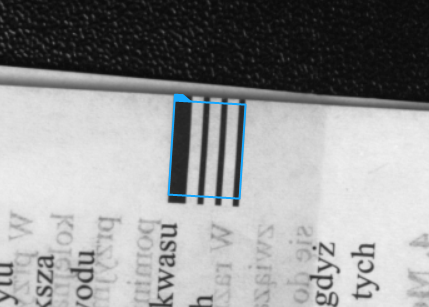
Results of reading using a different Pharmacode directions: Pharmacode = 23 and PharmacodeInversed = 16.
Using a relative coordinate systems
For more information about local coordinate systems please refer to the following article.
Hardware Acceleration
This operation supports automatic parallelization for multicore and multiprocessor systems.
Complexity Level
This filter is available on Basic Complexity Level.
Filter Group
This filter is member of ReadBarcodes filter group.
See Also
- DecodeBarcode – Translates an array of bar widths to sequence of digits or text in accordance to the selected barcode standard.
- DetectMultipleBarcodes – Determines the positions of multiple barcodes on the input image.
- DetectSingleBarcode – Determines the position of a single barcode on the input image.
- RecognizeBarcode – Extracts information from a barcode located on the input image at a given position.


